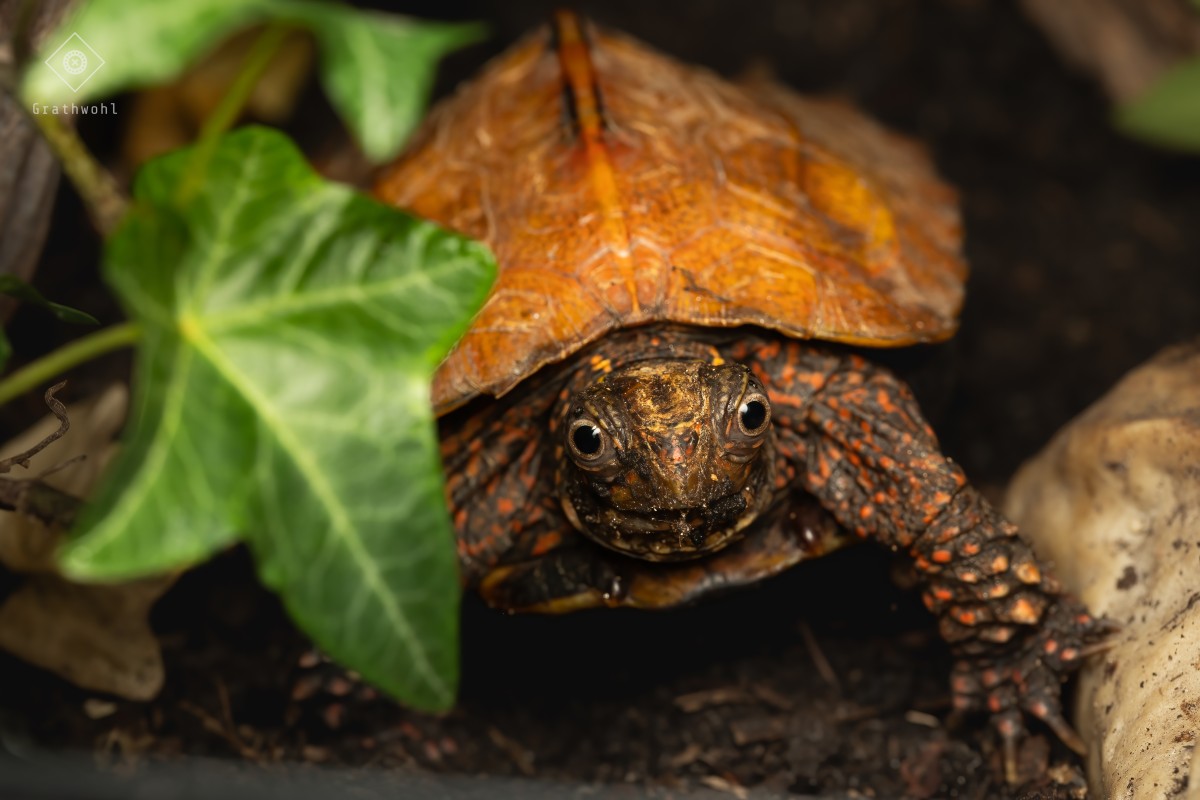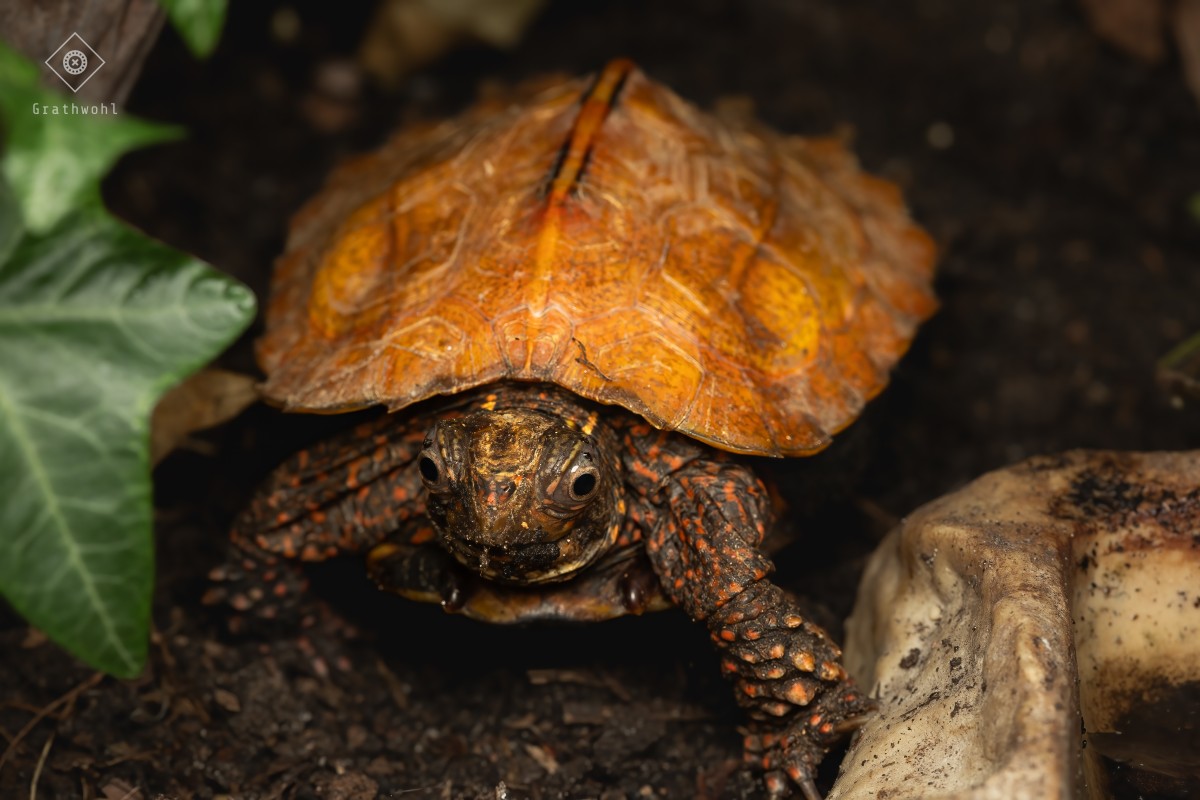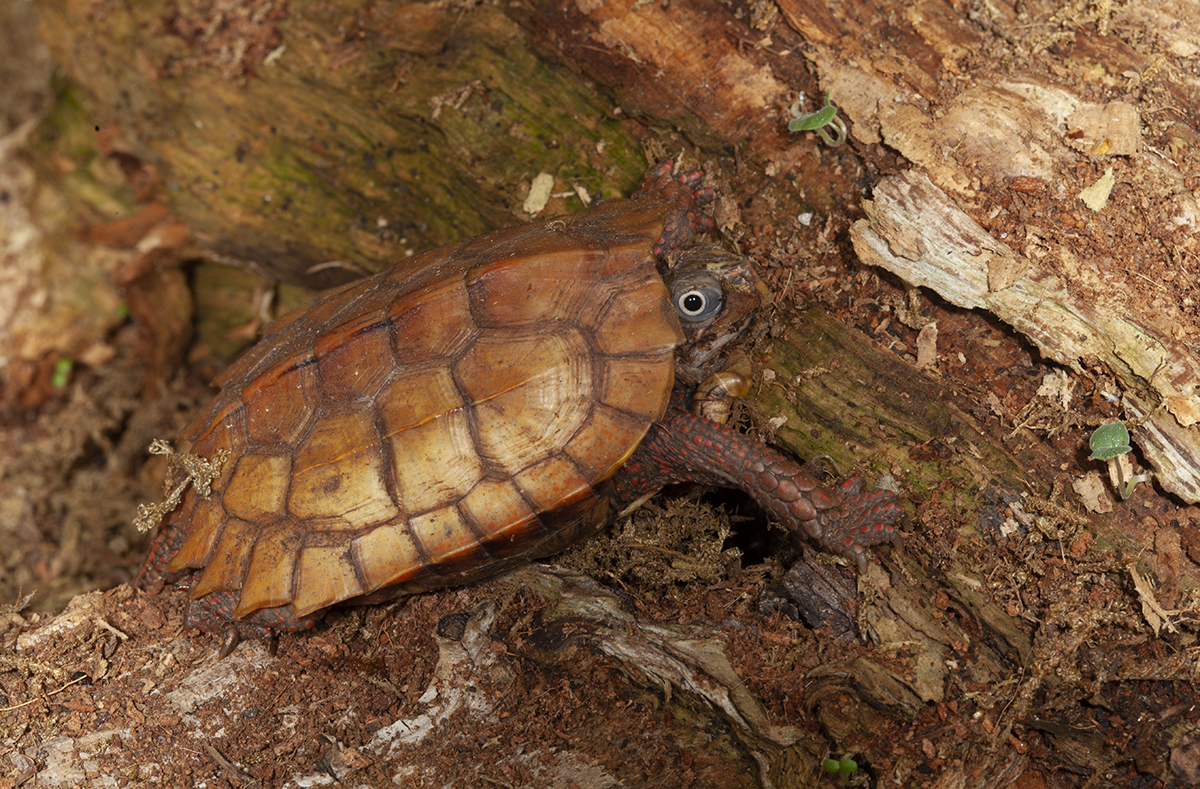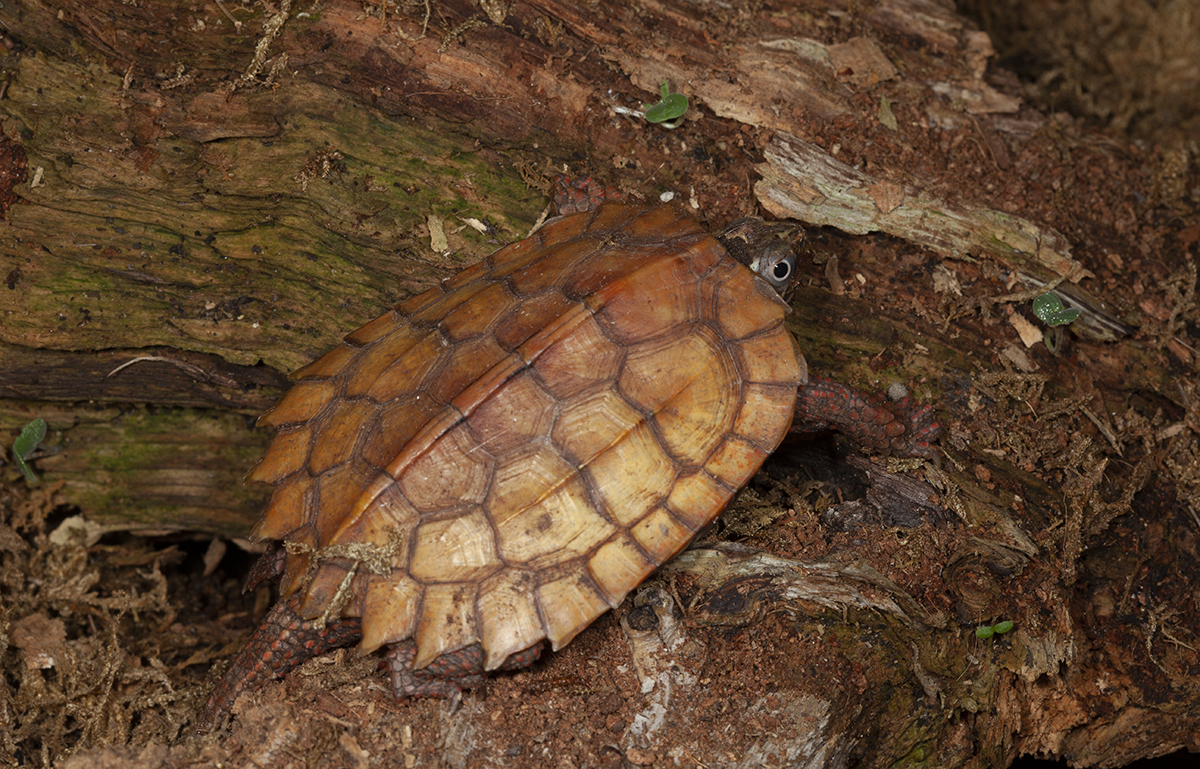Dyreriget – Krybdyr – Skildpadder – Østlige Sumpskildpadder
Geoemyda spengleri
Vietnamesisk Bladskildpadde


Taxonomy
- Testudo spengleri Gmelin, 1789 – holotype is missing – type locality is unknown
Geoemyda spengleri (Gmelin, 1789) – genus described by Gray in 1834 with spengleri as its type-species
Emys spengleri (Gmelin, 1789)
Nicoria spengleri (Gmelin, 1789)
Geoemyda spengleri spengleri (Gmelin, 1789) - Testudo tricarinata Bory, 1804
Geoemyda tricarinata (Bory, 1804) - Geoemyda spengleri sinensis Fan, 1931
Common Names
English: Black-Breasted Leaf Turtle
German: Chinese Zacken-Erdschildkröte
Danish: Kinesisk Bladskildpadde
Etymology
The species is named in honor of the Danish intendant of the Royal “Kunstkammer” and naturalist Lorenz Spengler (1720-1807), who delivered a shell of this species to Wahlbaum (Uetz et al, 2019). Spenglers primary interst in natural history was in conchs.
Description
This is a small turtle – measuring up to 13-15 cm in carapace length. Males weigh up to 110 grams and females up to 180 grams (Hofer, 2000)
According to Hofer (2000), the older males, has a flesh-colored patternless head and neck, and ever younger males have much less pattern than females. He mentions that females have two longitudinal yellow stripes on the head and neck, with red or even blue spots. Obst (1985) mentions, that males have whitish pupila, but this don’t seem to be a general character.
The most precise way to tell the sexes apart is by comparing the tail sizes. The males have longer and wider tails than the females.
Hofer (2000) noticed, that males tend to walk with their tail straight – wereas females walk with their tail inside the carapace.
Distribution
Found in southern China (Guangdong, Hainan Island, Kwangsi and Kwangtung provinces), Laos and Vietnam.
The Black-Breasted Leaf Turtle inhabits cool and humid mountain rainforests in 800-1000 meters hight – were it lives hidden in the fallen leafs and vegetation. In Tam Dao, were spengleri has been found, up to 2000 mm of rain falls every year – and a high median humidity of 83% is present by a medial temperature of 21,7-23,8° C (Kronberger, 1962). Although this turtles family suggest that it might be an aquatic species, this is not the case, and it don’t like deep water as it don’t swim very well.
Keeping
I keep my young group in a terrarium measuring 100x60x50 – it is placed in a cool room, and is not heated. It is lighted by a two Neon-tubes and a single UV light bulb. The terrarium is filed with a layer of 5-10 cm forest-bedding, mixed with mosses, and decorated with heavy branches and a few plants (Scindapsus, ferns etc.). I spray the terrarium heavily 3 times a week, and from time to time, ad a lot of water to the substrate, to keep it constantly humid. The animals are not social, so they tend to use hides away from each other, and i will soon try to split the group into two or three terrariums, to keep them from each other. This should also help in future breeding trials, as especially the males, can be quit stressfull and agressive.
The turtles hide a lot during the day, but when sprayed they all show up, and hunt for food or search the terrarium to drink. I have a flat water-bowl, fitting the size of the turtle, giving them the possibility of placing them self in the water, without having to swim. As they like to do this, its a good idea, to have a water bowl, that is easy to clean.
Food
The turtles are primarily carnivors, but some should also eat a bit of sweet fruit. I have tried to offer mine blue-berries without any luck. I feed primarily earthworms, mealworms, Zophobas, crickets (Gryllus bimaculatus) and occasionally pinky mice (dead), but they also eat small snails, slugs, locusts, and some even eat small fish (i have not had luck with thawed fish so far). Hofer (2000) theorize, that the species in nature might be able to turn over rocks to search for worms and snails. He base his theory of an observation of an old male, that lifted the food-bowl with one of its front-legs to catch a worm, that had crawled beneath it.
Breeding
Hofer (2000) recommends a hibernation period for the animals, to get them to breed – its not necessary, but in his experience, eggs was not fertilized before he started hibernating his animals. He advice to hibernate the animals by slowly decreasing the hours of light, and the humidity in the enclosure – then ending the feedings and after 3-4 placing them single in containers filled 1/3 with moist betting, at a temperature of 8-10° C for 30-60 days.
After the hibernation, the animals are left to wake up again in their terrariums. When fully awake, the male is introduced to the female/females, and he will soon try to mate. If the female is interested, she will let him get to her, and they will copulate. The males are very sexual active after the hibernation, and care is to be taken, to seperate the male again, to avoid stress to the female (Hofer, 2000).
One or two eggs are laid, often in the turtles burrow. Eggs droped in the open, are normally infertile. Hofer (2000) incubated an egg measuring 3,9 x1,9 cm when freshly laid. It was incubated in moist Vermiculite at a constant temperature of 25° – after 65 days, the egg hatched. The newly hatched juveniles weighed 3 grams and measured 2,7 x 1,8 cm. Young turtles are kept single – they are kept like the adults.
Conservation status
Like most other south-east asian turtles, this species is threatened by especially human consumption in China.
Literature
- Anonymous 1966 Schildkröten Lexikon. Die Zacken-Erdschildkröte, Geoemyda spengleri spengleri Aquarien Terrarien, 13(12): 411.
- Bakowskie, R. & K. Gärtner 2009 Bemerkenswerte Beobachtung bei der Nahrungsaufnahme einer Geoemyda spengleri (Gmelin, 1789) im Terrarium Radiata, 18(2): 30-32.
- Bourget, T. & V. Bourget 2000 Note sur la reproduction en captivité de Geoemyda spengleri (Gmelin, 1789) Manouria, 7): 20-22.
- Buskirk, J.R. 1993 Captive propagation and husbandry of the Vietnamese leaf turtle (Geoemyda spengleri) Vivarium, 5(3): 28-33.
- Eckelmann, G. 1966 Eiablage bei Geoemyda spengleri spengleri Aquarien Terrarien, 13(1): 32.
- Fan, T.H. 1931 Preliminary report of reptiles from Yaoshan, Kwangsi, China Bull. Dept. Biol. Col. Sci. Sun Yatsen Univ., 11(4): 1-156.
- Franklin, C.J. 2005 Vietnamese Wood Turtle (Geoemyda spengleri) Reptiles Magazine, 13(11): 60-61.
- Gad, J. 1994 Die Ultrastruktur der Eischalen von Geomyda spengleri, Indotestudo elongata und Sacalia bealei (Testudines) Salamandra, 30(4): 277-280.
- Gad, J. 1998 Beobachtungen zum Paarungsverhalten von Geoemyda spengleri Salamandra, 34(4): 323-332.
- Gmelin, S.G. 1789 Caroli a Linné. Systema Naturae per regna tria naturae 13th ed., vol. 1, part 3. Pp. 1033-1516.
- Gong, S., H. Shi, Y. Mo, M. Auer, M. Vargas-Ramírez, A.K. Hundsdörfer & U. Fritz 2009 Phylogeography of the endangered black-breased leaf turtle (Geoemyda spengleri) and conservation implications for other chelonians Amphibia-Reptilia, 30(1): 57-62.
- Gray, J.E. 1834 Characters of two new genera of reptiles (Geoemyda and Gehyra) Proc. Zool. Soc. London, 1834: 99-100.
- Gurley, R. 2002 Quelques notions d’élevage chez Geoemyda spengleri, la Geeoémyde de Spengler Manouria, 5(17): 9-11.
- Hilgenhof, R.J. 2001 Zur Haltung und Nachzucht von Spenglers Vietnamesischer Zacken-Erdschildkröte Geoemyda spengleri (Gmelin, 1789) Radiata, 10(1): 3-12.
- Hofer, A. 2000 Haltung und Nachzucht der Zacken-Erdschildkröte Geoemyda spengleri (Gmelin, 1789) In: Artner, H. & E. Meier (eds.). Schildkröten, Symposiumband. Natur und Tier Verlag, Münster, 181 pp Pp. 93-97.
- Jasser-Häger, I. 2004 Drei außergewöhnliche Beobachtungen bei der Haltung und Nachzucht von Geoemyda spengleri Schildkröten im Fokus, 1(3):3-10.
- Jasser-Häger, I. & A. Saus 2006 Naturnahe und Verhaltensgerechte Eingewöhnung, Haltung und Nachzucht der Zacken-Erdschildkröte (Geoemyda spengleri) (Gmelin, 1789) Marginata, (11)3(3): 21-30.
- Jasser-Häger, I. & H.-D. Philippen 2003 Bemerkungen zur Haltung und Zucht der Zacken-Erdschildkröte (Geoemyda spengleri Gmelin 1789) Draco, (13)4(1): 46-52.
- Jasser-Häger, I. & M. Baur 2005 Acclimation et élevage de la Géoémyde de Spengler, Geoemyda spengleri (Gmelin, 1789) Manouria. 8 (26):10-20.
- Kronberger, H. 1962 Gepanzerte Gäste aus Vietnam Aquarien Terrarien, 9(1): 22-25.
- Lüthi, H.-J. 1974 Erfolgreiche Pflege und Zucht der Zacken-Erdschildkröte Geoemyda spengleri spengleri Das Aquarium, (60)(6): 264-268.
- Marby, H. 1956 Geoemyda spengleri DATZ, 9: 265.
- Nicol, E. 1993 Geoemyda spengleri spengleri – suggestions for care in captivity Notes from NOAH, 1993
- Obst, F.J. 1985 Die Welt der Schildkröten Müller, Verlag, Stuttgart, 235 pp.
- Pawlowski, S. 2017 Unerwartete Eiablage bei einer Nachzucht der Zacken-Erdschildkröte Geoemyda spengleri (Gmelin, 1789) Sauria, 39(4): 41-46.
- Pawlowski, S. & C. Krämer 2009 Bemerkungen zur Bestandssituation, Haltung und Nachzucht der Zacken-Erdschildkröte Geoemyda spengleri (Gmelin, 1789) Sauria, 31(3): 35-40.
- Petzold, H.-G. 1977 AT Terrarientierlexikon Geoemyda s. spengleri (Gmelin, 1789) Zacken-Erdschildkröte Aquarien Terrarien, 24(8): 288.
- Philippen, H.-D. 2006 Die Zacken-Erschildkröte, Geoemyda spengleri (Gmelin, 1789) Eine Faszinierende Art Marginata, (11)3(3): 10-15.
- Pierlioni, A. 2016 Die anspruchsvolle Nachzucht der Zacken-Erdschildkröte Geoemyda spengleri Radiata, 24(1): 30-35.
- Richter, M. 2012 Haltung und Vermehrung der Zacken-Erdschildkröte, Geoemyda spengleri (Gmelin, 1789) Radiata, 21(3): 15-23.
- Rudloff, H.-W. 1986 Beitrag zur Kenntnis er Zacken-Erdschildkröte Geoemyda spengleri spengleri (Gmelin, 1789) herpetofauna(D), 8(40): 14-20.
- Schaefer, I. 2006 Naturnahe Ernährung der Zacken-Erdschildkröte (Geoemyda spengleri) Marginata, (11)3(3): 16-20.
- Uetz, P., Freed, P. & Hošek, J. (eds.). 2020. The Reptile Database, http://www.reptile-database.org
- Van, T.P., T.V. Tien, J.E. Dawson, T.B. Thanh & B. Leprince 2018 Natural history observations on the endangered turtle Geoemyda spengleri in Tay Yen Tu Nature Reserve (Vietnam), with notes on other sympatric species Herp. Bull., 146: 1-7.
- Yasukawa, Y. & H. Ota 2010 Geoemyda spengleri (Gmelin 1789) – Black-Breasted Leaf Turtle Chel. Res. Monogr., 5: 047.1-047.6.
- Yasukawa, Y., H. Ota &T. Hikida. 1992. Taxonomic Re-evaluation of Two Subspecies of Geoemyda spengleri spengleri (Gmelin, 1789) (Reptilia: Emydidae). Japan. J. Herpetol., 14(3): 143-159.

